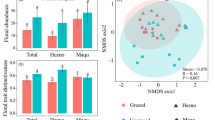Summary
The ‘plant defense guild’ hypothesis for the evolution of plant secondary chemicals predicts that plant species defend themselves against generalist herbivores such as the snowshoe hare (Lepus americanus) in the Canadian boreal forest by evolving unique antifeedant chemicals. Plant species may coevolve in an ecosystem by presenting an array of chemicals to herbivores. We report further evidence for this idea from the presence of 2,4,6-trihydroxydihydrochalcone in the CH2Cl2 extracts of Populus balsamifera juvenile twigs. These extracts, added to rabbit chow, were offered to hares in choice tests. The bioassay established that the chemical acted as an antifeedant for hares.
Similar content being viewed by others
References
Atsatt PR, O'Dowd DJ (1976) Plant defense guilds. Science 193:24–29
Bernays E, Graham M (1988) On the evolution of host specificity in phytophagous arthropods. Ecology 69:886–892
Bohlmann F, Abraham W-R (1979) Neue, chlorsubstituierte thiophenacetylenverbingungen mit ungewöhnlicher Struktur aus Helichrysum-Arten. Phytochemistry 18:839–842
Bristow CM (1988) Is diet choice a picnic for leaf-cutter ants? Trends in Ecology and Evolution 3:153–154
Bryant JP, Kuropat PJ (1980) Selection of winter forage by subarctic browsing vertebrates: the role of plant chemistry. Annu Rev Ecol Syst 11:261–285
Bryant JP, Wieland GD, Reichardt PB, Lewis VE, McCarthy MC (1983) Pinosylvin methyl ether deters snowshoe hare feeding on green alder. Science 222:1023–1025
Clausen TP, Reichardt PB, Bryant JP (1986) Pinosylvin and pinosylvin methyl ether as feeding deterrents in green alder. J Chem Ecol 12:2117–2131
Ehrlich PR, Raven PH (1964) Butterflies and plants: a study in coevolution. Evolution 18:586–608
Feeny PP (1976) Plant apparency and chemical defense In Biochemical interactions between plants and insects. Wallace JW, Mansell RL (eds) Recent advances in Phytochemistry Vol 10. Plenum, New York, pp 1–40
Fox LR (1981) Defense and dynamics in plant-herbivore systems. Am Zoo 21:853–864
Jermy T (1988) Can predation lead to narrow food specialization in phytophagous insects? Ecology 69:902–904
Klein DR (1977) Winter food preferences of snowshoe hares (Lepus americanus) in interior Alaska. International Congress of Game Biologists, Proceedings 13:266–275
Krebs CJ, Gilbert BS, Boutin S, Sinclair ARE, Smith JNM (1986) Population biology of snowshoe hares. I. Demography of food supplemented populations in the southern Yukon, 1976–84. J Anim Ecol 55:963–982
Mattes BR, Clausen TP, Reichardt PB (1987) Volatile constituents of balsam poplar: the phenol glycoside connection. Phytochemistry 26:1361–1366
Reichardt PB, Bryant JP, Clausen TP, Wieland GD (1984) Defense of winter-dormant Alaska paper birch against snowshoe hares. Oecologia 65:58–69
Rhoades DF (1985) Offensive-defensive interactions between herbivores and plants: their relevance in herbivore population dynamics and ecological theory. Am Nat 125:205–238
Rhoades DF, Cates RG (1976) Toward and general theory of plant antiherbivore chemistry. In Biochemical interactions between plants and insects. Wallace JW, Mansell RL (eds) Rec Adv Phytochem Vol 10. Plenum, New York, pp 168–213
Schultz JC (1988) Many factors influence the evolution of herbivore diets, but plant chemistry is central. Ecology 69:896–897
Siegel S (1956) Nonparametric statistics. McGraw-Hill, New York
Sinclair ARE, Jogia MK, Andersen RJ (1988) Camphor from juvenile white spruce as an antifeedant for snowshoe hares. J Chem Ecol 14:1505–1514
Sinclair ARE, Krebs CJ, Smith JNM, Boutin S (1988) Population biology of snowshoe hares. III. Nutrition, plant secondary compounds and food limitation. J Anim Ecol 57
Sinclair ARE, Smith JNM (1984) Do plant secondary compounds determine feeding preferences of snowshoe hares? Oecologia 61:403–410
Smith JNM, Krebs CJ, Sinclair ARE, Boonstra R (1988) Population biology of snowshoe hares. II. Interactions with winter food plants. J Anim Ecol 57:269–286
Author information
Authors and Affiliations
Rights and permissions
About this article
Cite this article
Jogia, M.K., Sinclair, A.R.E. & Andersen, R.J. An antifeedant in balsam poplar inhibits browsing by snowshoe hares. Oecologia 79, 189–192 (1989). https://doi.org/10.1007/BF00388477
Received:
Issue Date:
DOI: https://doi.org/10.1007/BF00388477




